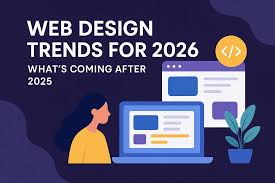In a fast-moving digital world, a strong website isn’t just “good to have”—it’s a business necessity. As we move into 2026, web design is evolving rapidly. It’s not only about how a site looks, but how it works, how it connects, and how it adapts. Here’s a breakdown of key areas to focus on when developing web design solutions in the coming year.
AI-Powered Design & Smarter Workflows
The role of artificial intelligence is shifting from a novelty to a core design partner. In 2026, expect web design workflows where AI contributes layout suggestions, rapid prototyping, even content generation — while human designers provide the vision and strategy.
What you can do:
Choose tools or frameworks that integrate AI-assisted design (for example, for wireframing or testing variations).
Use AI to handle repetitive work (e.g., generating CSS variants, preparing elements), so your team can focus on user experience and storytelling.
Ensure you maintain design control—AI gives options, you choose direction.
Mobile‑First & Future‑Proofing Across Devices
By 2026, the “mobile first” mindset isn’t optional—it’s expected. With more users on mobile and browsers/devices diversifying, your design solution must perform across screens, devices, and even future client‑contexts.
Implementation tips:
Start your layout designing for smaller screens, then scale up (not the other way around).
Use responsive design, but also think about progressive enhancement—so basic functionality works everywhere.
Test across device types: foldables, tablets, large desktops, and even non-traditional devices (TVs, kiosks) if relevant.
Immersive Visuals: 3D, Motion & Engagement
Gone are the days when a static page just needed high-res images. In 2026, motion, depth, and interactive visuals take centre stage. Websites will increasingly use responsive 3D elements, micro‐interactions, and fluid animations to engage users.
Best practices:
Use 3D or motion strategically—not everywhere, but to highlight key points or tell a story.
Ensure performance remains solid (slow load times kill engagement).
Use animation to guide action (e.g., hover effects, interactive visuals), but maintain usability.
Personalisation, Accessibility & Human‑Centric Design
Users now expect online experiences to feel tailored. That means design solutions must be both inclusive and intelligent—adapting to user behaviour, preferences, and accessibility needs.
How to apply:
Use data or behavioural cues (with care for privacy) to customise elements of the website—e.g., greet returning visitors, adjust layout for preferred content types.
Build for accessibility from the start: ARIA roles, keyboard navigation, high‑contrast visuals, and responsive layouts.
Keep the human element alive: even with AI and customisation, design must feel welcoming, not robotic.
Minimalism meets Character: Retro, Brutalism & Bold Typography
While a clean, minimalist design remains, 2026 brings a twist: designs that embrace character and personality. Think bold typography, brutalist layouts, retro elements, and visible structure as design features. Anax Designs is a growing name in the field of website solutions.
What this means:
Consider mixing minimalist foundations with expressive accents (e.g., headline typography that stands out).
Use layout asymmetry, imperfect lines, or “raw” textures to bring authenticity.
Align the visual style with the brand’s voice—if your brand is bold and quirky, the design can show it.
Sustainability, Ethics & Performance
In 2026, design solutions shouldn’t ignore environmental or ethical considerations. Performance impacts carbon footprint; design decisions affect accessibility and user empowerment.
Actionable steps:
Monitor page size, optimize images, reduce unnecessary scripts—faster sites mean less energy & better UX.
Use sustainable hosting or review your hosting provider’s footprint.
Make your design decisions inclusive: don’t rely only on trendy visuals that might exclude users (e.g., low‑contrast text, motion triggers).
Strategy & Maintenance: It’s Not “Launch and Forget.”
A website in 2026 isn’t a one-time project—it’s a constantly evolving ecosystem. From integrating new tools to responding to user data and shifting design trends, your web design solution must include a plan for updates and evolution.
What to include in client proposals or your internal plans:
A roadmap for periodic review (visual style, performance metrics, SEO).
Ongoing analytics and user feedback loops to inform changes.
Modular structure so you can swap or upgrade components (e.g., integrate new web‑components, update 3D visuals, tweak UI patterns) without rebuilding from scratch.
Final Thoughts
Designing for 2026 means more than picking a colour palette or responsive grid—it means building a web presence that is smart, agile, and human-centred. If you focus on AI-enhanced workflows, mobile-first thinking, immersive visuals, personalization + accessibility, aesthetic personality, and sustainable practices—you’ll be well‑positioned to deliver web design solutions that truly stand out.
